Looking for the best things to do in Hoi An without getting lost in a sea of tourist traps? You’re not alone. This exquisite riverside town in Central Vietnam is packed with picture-perfect corners, colorful lanterns, and more tour options than you can count—which makes it both magical and, at times, overwhelming. With three visits under my belt (and plenty of trial and error), I’ve sifted through the must-dos, the overrated, and the hidden gems to bring you a curated list of Hoi An experiences that are actually worth your time.
Just so you know, this post contains affiliate links. If you book a tour, hotel, or buy something through one of these links, I may earn a small commission—at no extra cost to you. It helps me keep this blog running and full of travel tips. Thanks for the support!

Why should you visit Hoi An, Vietnam?
Having visited 48 countries and countless cities, I’d count Hoi An among my favourites. I’ve been three times, first in 2010, and again in October 2024 and April 2025, and the city has stood the test of time. Like George Town and Malacca in Malaysia and Luang Prabang in Laos, Hoi An is a UNESCO Heritage site, and it’s no surprise that all of these were among my favourite visits in Southeast Asia.
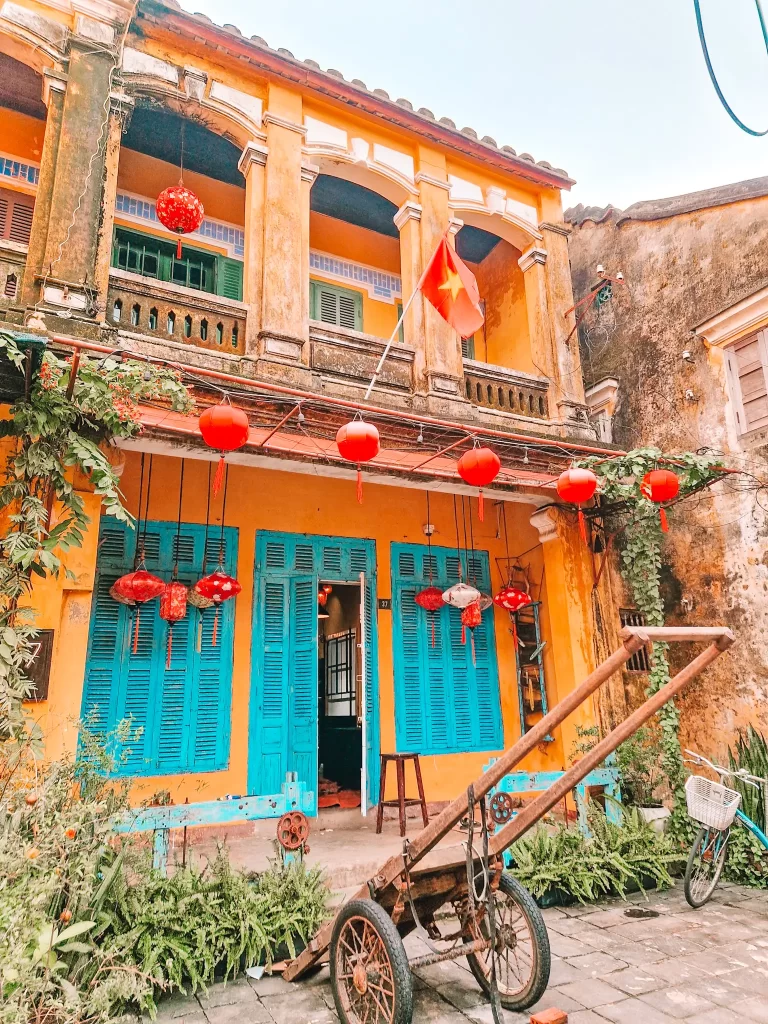
Hoi An has seen relatively little change despite Vietnam’s rapid boom, and it retains its old-world charm. It’s one of Vietnam’s most historic cities, with beautiful buildings lining a picturesque river. The low-rise streets stand in complete contrast to neighbouring Da Nang where high-rises rule and construction is booming. The gorgeous pedestrianised city is full of small cafes and souvenir shops, as well as the tailoring workshops that made Hoi An famous.
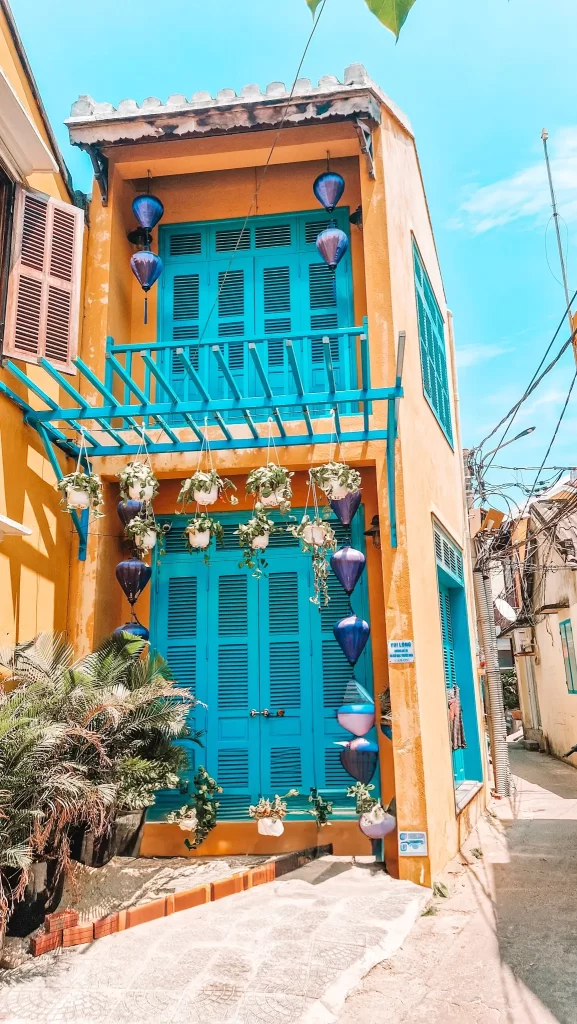
This Hoi An guide will help you to make the most of your stay—whether that’s soaking up the historic Old Town streets, floating down the river in a glowing lantern boat, getting a custom-tailored outfit, or gliding through the coconut groves in a basket boat (yes, it’s touristy, but I’ll tell you how to do it right). Think of this as your shortcut to the heart of Hoi An—authentic, memorable, and just the right balance of culture and calm. Ready to dive in? Let’s make your Hoi An trip unforgettable.
History of Hoi An
Hoi An, located on Vietnam’s central coast, was a major Southeast Asian trading port from the 15th to 19th centuries. Influenced by Chinese, Japanese, and European merchants, the town flourished culturally and economically. Hoi An’s famous tailoring tradition dates back to its days as a bustling port, where silk traders and merchants fueled a craft that evolved into the city’s renowned custom tailoring industry today.
Its Old Town, now a UNESCO World Heritage Site, preserves centuries-old architecture and a unique blend of cultures. While much of Vietnam experienced significant damage during the Vietnam War, Hoi An spared major destruction, one of the reasons its historic charm remains a powerful draw for modern visitors.
If you’re interested in Vietnamese history, check out the beautiful and well-researched historical novels in my guide to books about Southeast Asia.
Best things to do in Hoi An – The Amazing Experiences You’ll Love
Explore Hoi An’s faded beauty
Cost: free
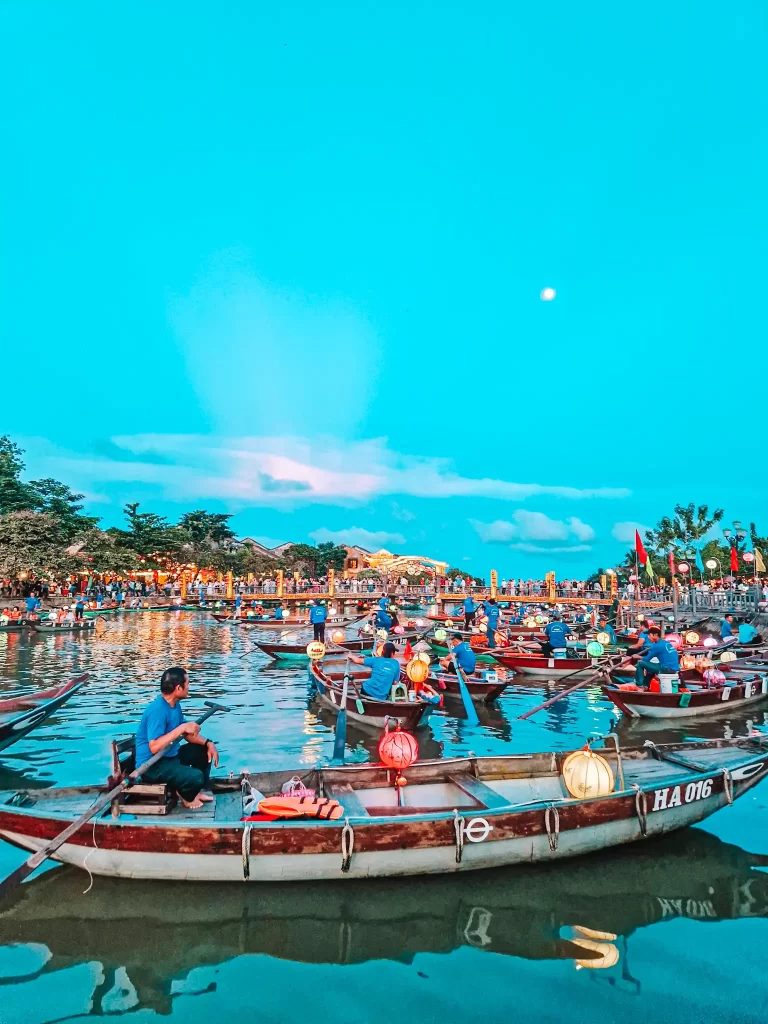
Honestly, the best thing to do on your Hoi An itinerary is just to wander the streets. Hoi An has to be on the list of most beautiful cities in the world, with its yellow buildings dripping with blooms, small alleys, and traditional houses.
The city is a paradise for coffee lovers, with cafes every few metres, as well as shoppers, as it has some of the best and most unique souvenirs in Asia. Take your time, wander slowly, and enjoy.
Marvel at the Japanese Bridge and Hoi An’s Ancient Houses
Cost: 120K VND for the Hoi An Ancient Town Ticket
One of the most famous sites in Hoi An is the iconic Japanese bridge. Built in the 17th century with the support of Japanese businessmen, this bridge is a must-see in Hoi An and is even on Vietnamese banknotes.
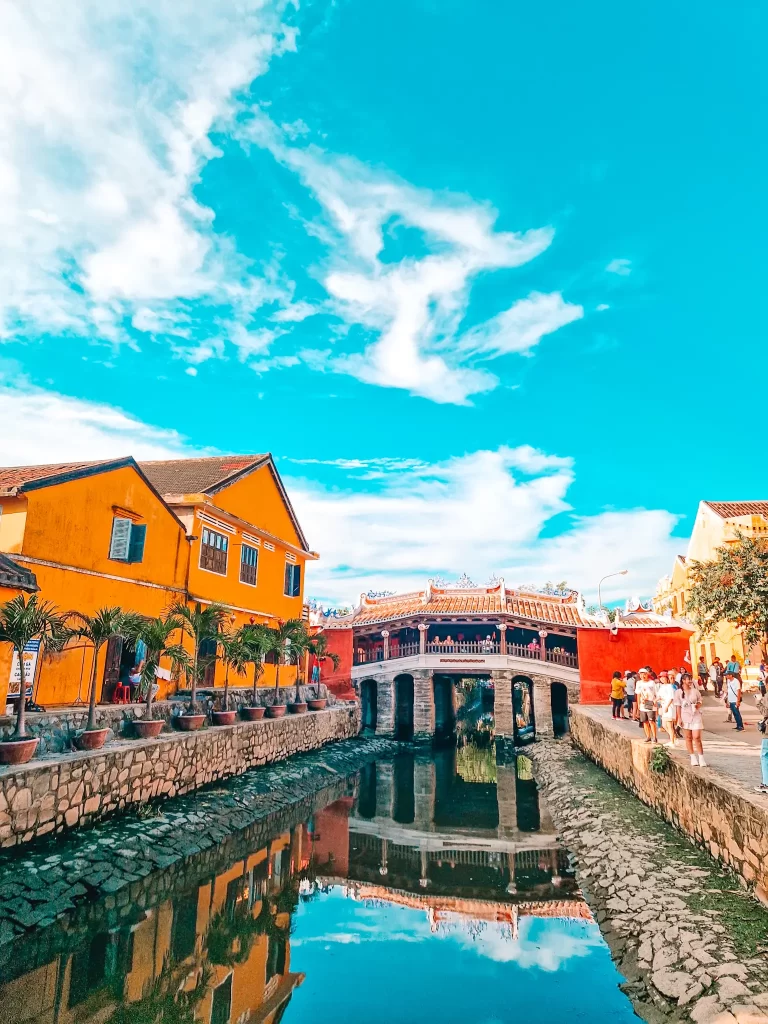
To visit/cross the Japanese bridge, you’ll need to buy a ticket to Hoi An’s cultural attractions. Known as a Hoi An Ancient Town ticket, this gives you access to a number of sites across the city in different categories. There is a ticket stall on one side of the bridge, as well as at a number of other spots around the town. You can see the Japanese Bridge from the riverfront for free, which gives you a chance to take beautiful pictures. However, not being able to cross it can be inconvenient.
Among other sites included in the ticket are several temples, which are beautiful to wander into as you walk around. My favourite things to do on the ticket are the ancient/old houses. These are traditional family homes which have been set up to reflect their past, and give a fascinating insight into life in Hoi An in the past. Some also have measures showing the height floods have reached at different points in Hoi An’s history. This shows the mindblowing impact that flooding has on the town on a regular basis.
- Tip: I found it difficult to keep track of which categories I’d visited and missed something I wanted to see as a result – it‘s worth taking a pen to tick them off as you go.
Experience the magic of a twilight lantern boat ride
Cost:
- 150K VND for 1-3 people, or 200K VND for 4-5 people (in October 2024)
- $1 for a paper lantern to float on the river
One of the most famous things to do in Hoi An is to take a lantern boat ride, and it’s worth the hype! Hoi An is famous for beautiful, ornate paper lanterns. As twilight approaches, boats all along the river will start to light their lanterns. The river takes on a magical glow as hundreds of boats cluster near the banks. You’ll also find locals selling small paper lanterns with candles inside. As you relax on your boat ride down the river, you can set your lantern free while making a wish.

The boat ride takes you from the bridge to An Hoi down to the bridge to Cam Nam and back. It’s a slow ride – the river is crowded! It was extremely busy when I went at around 6pm, just as it was getting dark. If you want a less crowded experience, consider going later.
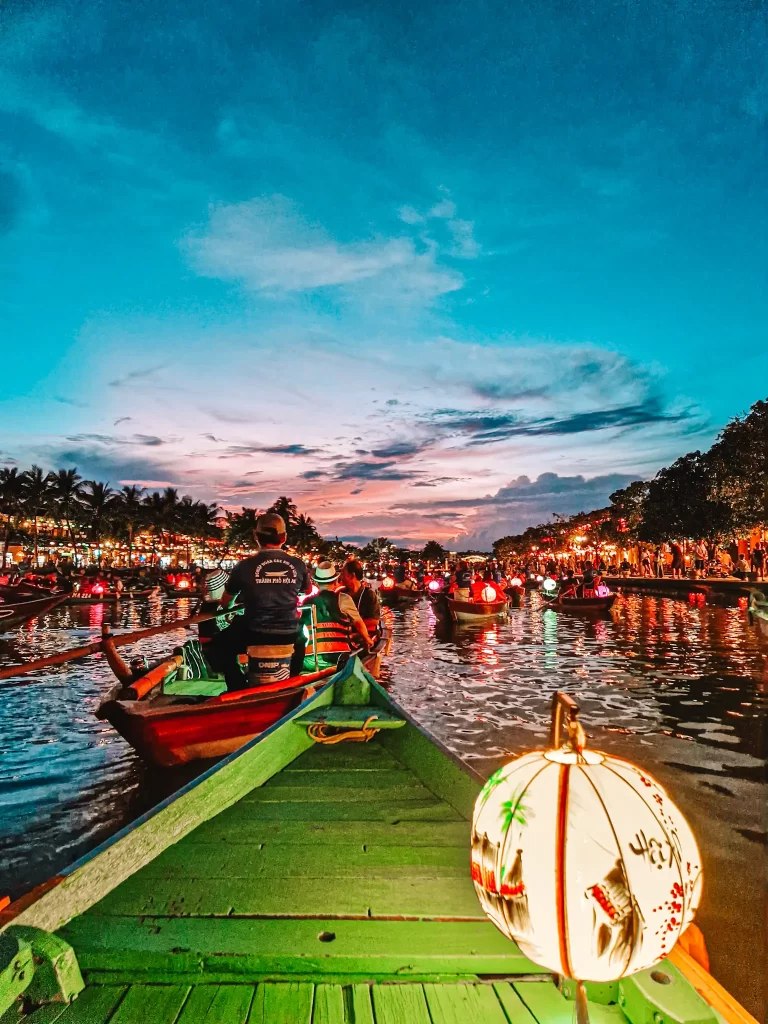
- Tip: use one of the official sellers. These have a set price and time, and are the best way to avoid being ripped off. They can be found at the end of the bridge across to An Hoi, opposite where the night market starts. As you walk through Hoi An at night, there will be many people approaching you for boat rides. These are not official boats and are likely to cost more.
Enjoy Hoi An at Night
Cost: free
More than anywhere else I’ve been, Hoi An feels like a nighttime town. The city comes alive at night, with the traditional, local-made lanterns lighting the streets. Just walking around feels magical, and that’s before you even get to the river.
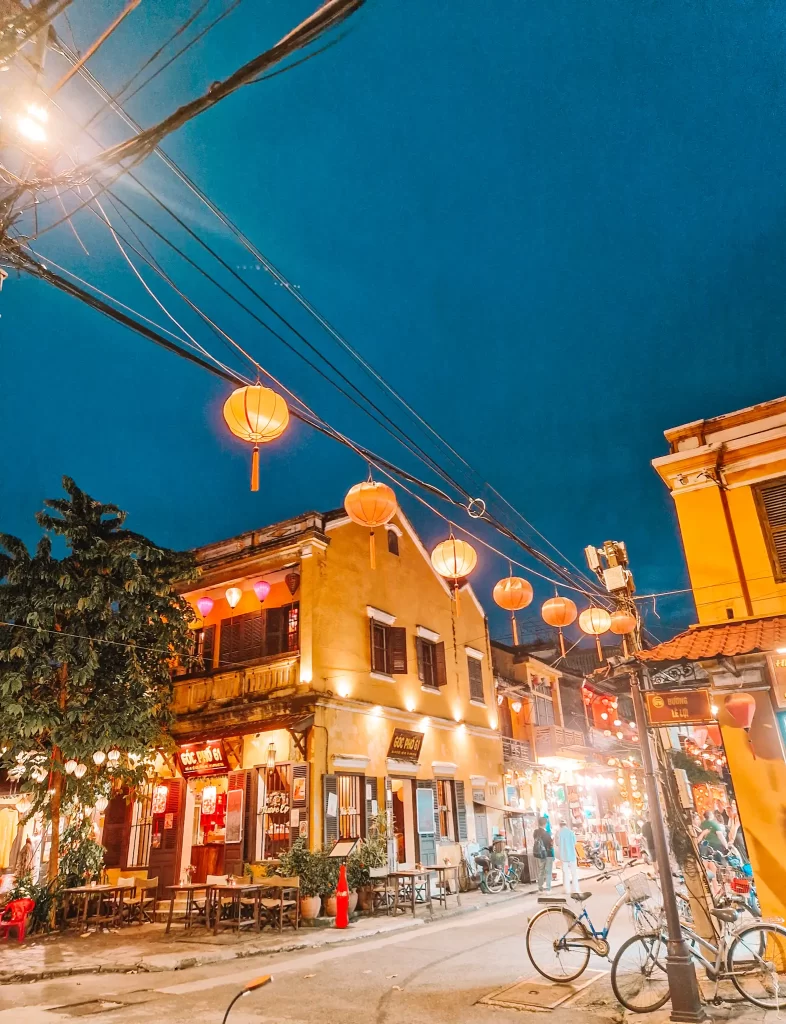
Visit the night market on An Hoi island for a busy, bustling shopping experience. This starts up around 5pm and there are stalls selling a range of souvenirs. The riverfront at An Hoi is also full of bars – it’s a great place to stop and have a drink. There’s even a Mr Bean-themed bar, if you’re a fan of the man and his bear.
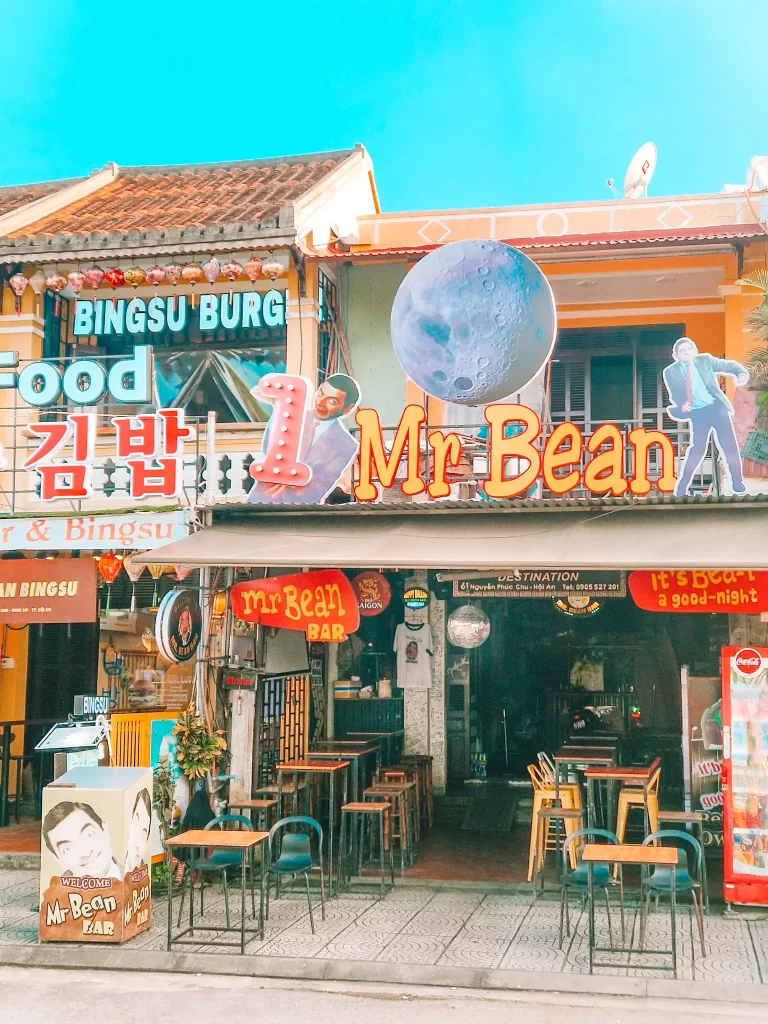
You can also visit Hoi An’s delicious restaurants, many of which have outside seating. There are also quieter bars in the main town if the bustle of An Hoi is too much for you. I really enjoyed The Son Bistro, which has craft beers and a happy hour, and is highly rated for food. Home Taste Restaurant also has a balcony with beautiful river views.
Enjoy the peace and serenity of Reaching Out Teahouse
Cost: buy a drink
Just by the Japanese Bridge is the beautiful and peaceful Reaching Out Tea House. Founded in 2021, Reaching Out Tea House is staffed by people with physical impairments, including people who are deaf. The tea house cultivates an atmosphere of quiet and tranquility, using order forms instead of verbal orders and encouraging guests to whisper.

It’s a chance to support an important social enterprise, while at the same time enjoying truly delicious coffees and teas. They offer tasting sets of both tea and coffee as well as a range of homemade biscuits. The drinks are presented with care, adding to the serene atmosphere.
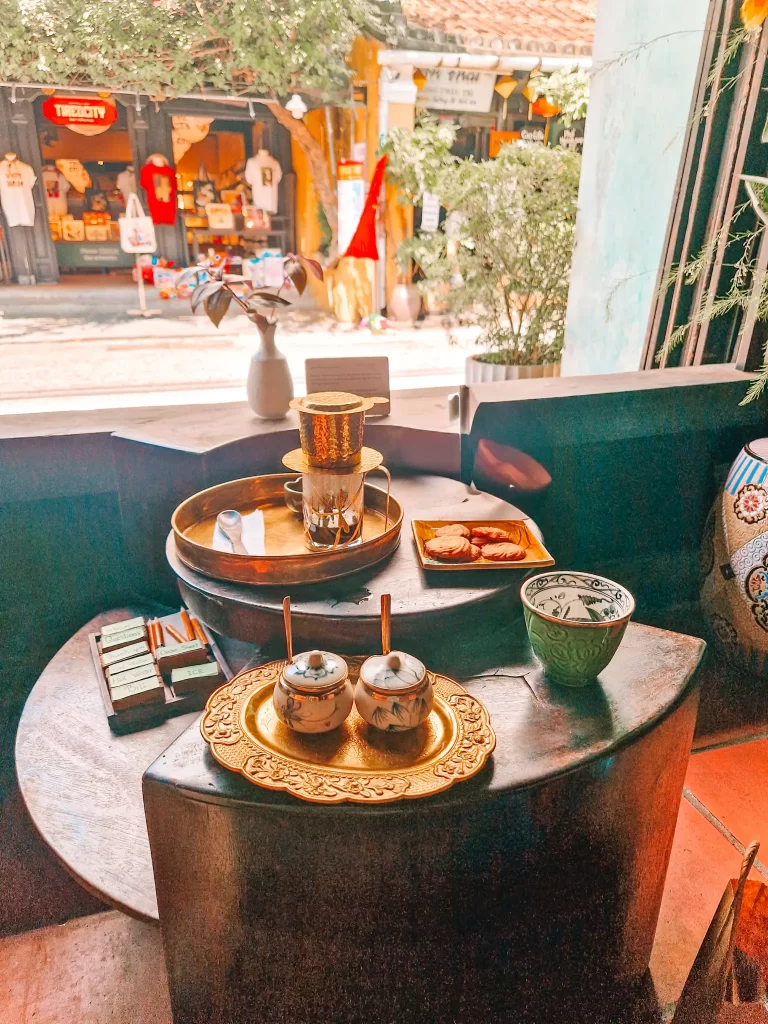
- Tip: Try to grab a spot in one of the windows overlooking the street – it felt like being in a fairytale.
Buy Some of the Cheapest Tailored Clothes in the World
Cost: depends on item and tailor
Hoi An is famous for tailoring, and shops are available throughout the city. Higher-end tailors have their own shops, while the main market has cheaper options. If this is your thing, take the time to browse the different shops to find the perfect outfit for you. You then typically return the next day for your final fitting.
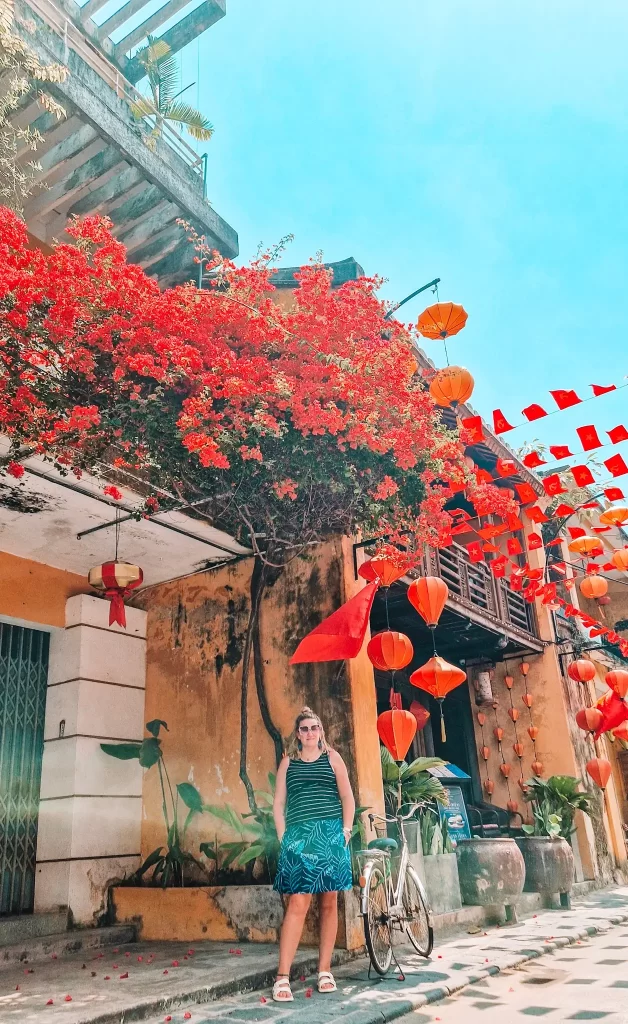
Having been to Hoi An twice without getting anything tailored, I finally took the plunge and got a dress, a skirt and some shoes in April 2025. I’ll be writing a full guide on my experience soon!
If tailoring is beyond your budget, Hoi An is still a great place to buy pre-made clothes, with lots of more casual clothes available from shops around the city.
- Tip: Many tailors are active on Tiktok or TripAdvisor. It’s worth noting that it’s common in Vietnam to ask customers to complete a review while staff are present (this happened during one of my appointments). This means that reviews can be skewed positive as people don’t want to be impolite.
Enjoy the river on a Coconut boat
Cost: 300k VND for a solo trip (significantly better value if you are two people)
One of the most famous things to do in Hoi An is to take a coconut boat along the river. When I visited Hoi An in 2010, this didn’t even exist, but today it’s immensely popular.
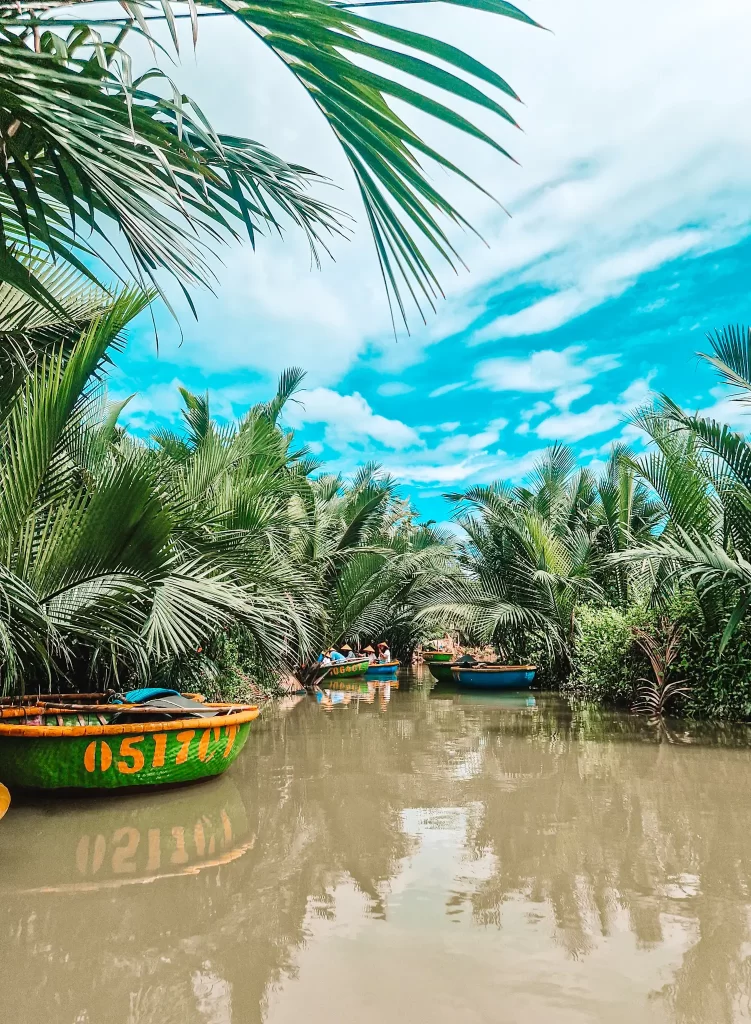
There are a number of places that you can go to hire a coconut boat. Your rower, often an older local woman, will paddle you down the main part of the river in a brightly painted round boat. You’ll turn into a smaller, quieter part of the river to row through nature, with the opportunity to fish for crabs along the way. Your rower will also likely make you some crafts using bamboo stripped from the nearby trees.

My hotel directed me to Phat Loc Eco Cooking. They offer boat rides, and the option to combine cooking classes and other activities. They were very friendly, spoke great English, and included a drink and cookies as part of the experience.
- Tips:
- I was offered the choice of the peaceful/natural route or the more touristy route. I chose the peaceful route, and saw very few other boats/people. If you choose the more touristy route, you can expect boats with loud speakers, lots of groups, and the option to do the famous spinning.
- Tipping is a ubiquitous part of the experience. My rower firmly asked for a tip as I was leaving, and I have heard that this is the norm across boat companies.
Lantern making class
Many of the shops in Hoi An offer the opportunity to make your own beautiful lantern, which you can then flat pack to take home. These classes always looked great as I passed them and I seriously considered doing one – I just didn’t have space in my backpack for even a flatpack lantern.
You can find lantern making classes on Get Your Guide or Viator, or ask your hotel. There are also many advertised as you walk around Hoi An.
Take a Day Trip out of the City
Cost: different per trip.
Tip: See my guide to day trips from Hoi An for full details on the options below
One of the other amazing things to do in Hoi An is leave Hoi An. There are many day trips from Hoi An if you want to see more of the country around the city. I wrote a full guide to day trips from Hoi An, but the most famous are:
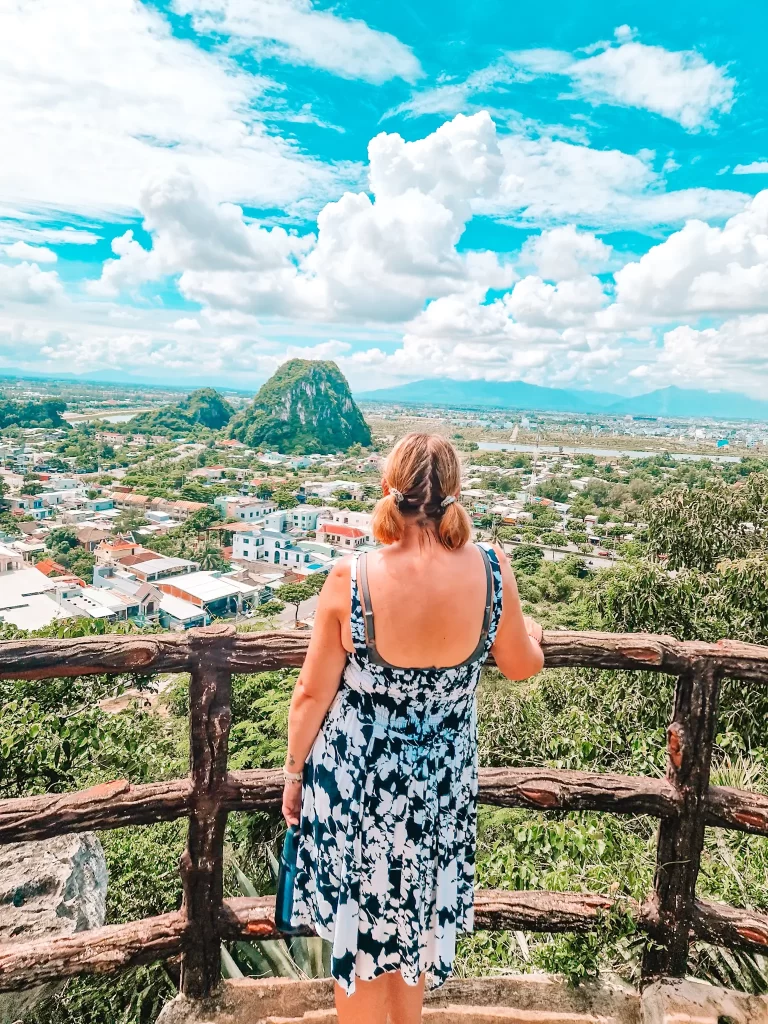
- My Son Archaeological Site – a UNESCO Heritage site featuring temples built by the Champa Kingdom between the 4th and 13th century. This is a great option if you love history both ancient and modern, because in addition to the stunning temples, you’ll see the damage caused by the Vietnam War.
- Marble Mountains – these stunning limestone karsts loom up out of the ground around Da Nang. You’ll visit the caves representing Hell, before ascending to the beautiful Heaven area of the Water Mountain.
- Lady Buddha – this huge statue near Da Nang was built during the noughties, and locals credit her with protecting the city from typhoon damage ever since. Visiting the site is a great way to experience a sense of peace (unless the monkeys are there, in which case guard your belongings!).
- Da Nang – this growing tourist city near Hoi An wasn’t on the tourist map when I visited Vietnam in 2010, but is now a popular spot for digital nomads, and offers a range of unique activities to enjoy on a day trip from Hoi An.
- Hai Van Pass – a popular trip from Hoi An is exploring the beautiful ocean scenery of the Hai Van Pass. I wrote a full guide about my Easyrider trip of the Hai Van Pass, where I visited the gorgeous Lang Co Beach, dipped my feet in the Elephant Springs and saw traditional fishing villages.
- Relax on An Bang Beach – this beautiful beach town is the nearest to Hoi An, and is a peaceful retreat from the city, full of gorgeous cafes

- Visit Hoi An’s rice fields – spend a morning cycling around the beautiful rice fields near Hoi An. You can visit some of the stunning cafes set among the lush greenery and see locals working on the rice harvest while sipping a salt coffee.

Frequently asked questions
How long should you spend in Hoi An, Vietnam?
Ideally, spend as long in Hoi An as you can – it’s a wonderful town. But realistically, that’s not always an option.
You need at least one full day to fully enjoy the town, but two days is ideal. This gives you time to wander around and take in the historic sights, take a coconut boat ride and enjoy the coffee and tea culture.
If you want tailoring done, you’ll need at least two days—for measurements, a first fitting, and a final fitting.
You’ll then need to consider any day trips you want to do and factor these in – either as half-day or full-day trips – and whether you want additional time at An Bang Beach.
Is Hoi An a good destination for solo female travelers?
Absolutely. Hoi An is considered safe and welcoming for solo female travelers. As always, take standard precautions —avoid poorly lit areas late at night and use Grab (the Asian version of Uber) instead of unlicensed taxis.
Is Hoi An Safe?
Many travelers wonder about safety in Vietnam. The good news is that Hoi An is considered one of the safest cities in Vietnam for travelers. Hoi An is a tourist-friendly town and remains active well into the evening. However, take the usual precautions, particularly if you are out late at night. For example, make sure to use Grab (the Asian version of Uber) rather than unlicensed taxis or motorbikes.
The British Foreign, Commonwealth and Development Office (FCDO) states that the most frequent types of crime in Vietnam are bag snatching and theft. However, Hoi An is considered one of the safest cities in the world for solo travellers. That said, it’s still wise to take standard precautions, especially late at night.
When is the best time to visit Hoi An?
The best time to visit Hoi An is the peak tourist season, from April to August. This offers drier weather and sunnier days, although temperatures soar in this season, reaching 40C in July and August.
September to March is considered the wet season, and is less popular with tourists.
How to get to Hoi An: Air
While Hoi An doesn’t have its own airport, Da Nang International Airport is less than an hour from Hoi An. It’s a modern airport with excellent facilities. Regular flights arrive from domestic destinations including Hanoi and Ho Chi Minh City, as well as international destinations like Bangkok, Kuala Lumpur, Singapore and Siem Reap.
To get from the airport to Hoi An, you can take Grab (the Asian version of Uber) for about 300K VND. You can also ask your hotel to organise a private transfer.
There are also shared shuttle buses, which you can book via 12goAsia.
How to get to Hoi An: Train
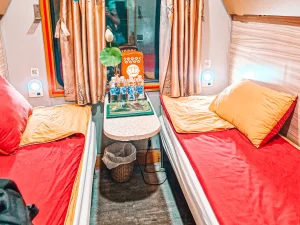
Around an hour from Hoi An, Da Nang has one of the main stations on Vietnam’s extensive railway network, which stretches from Ho Chi Minh City in the south to Hanoi and even Sapa in the north. Trains arrive and depart from Da Nang Train station, with departures to key destinations several times a day.
With the exception of Hue, most train journeys from Da Nang are long:
Hanoi – 17 hours
Ho Chi Minh – 19 hours
Hue – 3.5 hours
I wrote a full guide on the Vietnamese trains I took from Hoi An (via the train station in Da Nang) to Ninh Binh, and then from Hanoi to Sapa, I loved the experience!
How to get to Hoi An: Bus
Vietnam’s buses have gained internet fame in recent years, with the VIP Sleeper buses offering some of the best luxury bus travel in the world. Taking a bus from Hoi An to other destinations across Vietnam is a popular option, with destinations including Ninh Binh, Hanoi, Ho Chi Minh City, Hue, Nha Trang and others.
Since large buses can’t enter the Old Town, departure points are spread throughout the city. You’ll need to work out the best departure point for you, or some will offer a free pickup service via minivan.
Buses in Vietnam vary in terms of comfort and price, for example VIP sleeper Buses offer wide beds with a seat on either side of the aisle, while cheaper sleeper buses have much less space as they have three beds per row. Do your research in advance to figure out which option suits you best. I read reviews on 12GoAsia and on Google before selecting a company.
Is it easy to get around in Hoi An without speaking Vietnamese?
Yes, in most tourist areas, basic English is widely spoken, especially by hotel staff, tour guides, and Grab drivers. That said, learning a few phrases like “Xin chào” (hello) or “Cảm ơn” (thank you) is appreciated and can enhance your experience.
Google Translate is also helpful for more complex interactions.
What Should I Pack for Hoi An?
Bring light, breathable clothing for hot weather, a light rain jacket (especially in the wet season), sunscreen, insect repellent, and comfortable shoes for walking. For temples, bring clothing that covers shoulders and knees. Remember swimwear if you’re going to the beach or your hotel has a pool!
Is Tipping Expected in Vietnam?
Tipping isn’t mandatory in Vietnam, but it’s appreciated, especially in tourist-heavy areas. Small tips (10–20K VND) are common for porters, drivers, and local guides. In restaurants, rounding up or tipping 5–10% is a kind gesture but not required.
Can I Use Credit Cards in Hoi An?
Credit cards are accepted in many hotels, upscale restaurants, and tour agencies. However, cash (Vietnamese Dong or VND) is essential for markets, small shops, street food, and local taxis. ATMs are widely available, although withdrawal costs vary so check these out in advance (Google Maps can be a good source for this).
Where Should I Stay in Hoi An?

There’s an abundance of choice for hotels in Hoi An, from charming local stays to riverside resorts. While there are hotels in the Ancient Town itself, I’d personally be cautious about choosing these, as Hoi An is a town that really comes alive at night and you’re likely to experience street noise.
You can also choose to stay on one of the two islands opposite the main town. An Hoi is where the main night market happens, and the front street is lined with bars – I would avoid these areas. Beyond this, the back streets of the island are quieter.
I stayed on Cam Nam, where there are far fewer tourists. This quiet island is about 10 minutes walk from the Ancient Town, but feels a million peaceful miles away. While there are a number of hotels, there are still lots of private houses, and it feels much less touristy.
If you can afford it, there are also a lot of beautiful upmarket hotels lining the river. These have stunning views and are usually away from the noise of the main town.
Finally, you can choose to stay out in the rice fields themselves. There are many hotels offering stunning views, and usually swimming pools to keep you cool.
Options include:
Yen Villas – this is where I stayed, and I can’t recommend it highly enough. Rooms are spacious and clean. The air conditioning works well, and there is a beautiful small pool. The family running the small hotel are among the most helpful and kind people I’ve come across while travelling. It’s around $15 per night.
Hoi An Town Centre Hotel – on An Hoi, this highly rated hotel is budget/mid-range for Vietnam (around $20 a night). It has excellent reviews, and is away from the noise of the night market.
River Town Hoi An Resort and Spa – also on An Hoi, but on the riverfront, this 5* resort has over 2000 reviews, a 4.7 rating on google and costs around $75 per night.
Mulberry Collection Silk Eco – if you’re keen to stay on the mainland, this 4* hotel has over 700 reviews on google and a 4.5 rating.
Are there vegetarian or vegan options in Central Vietnam?
Yes! Vietnamese cuisine has excellent plant-based dishes, and you can find dedicated vegetarian and vegan restaurants in both Hoi An. Popular dishes include bánh xèo (local pancakes) with mushrooms, veggie pho, vegetable spring rolls and vegan versions of cao lầu. If you’re heading to Da Nang, check out my favourite vegan and vegetarian restaurants in the city.
Where should you go after Hoi An, Vietnam?
If you’re planning to spend more time in central Vietnam, check out my 10 day itinerary which covers Hoi An, Da Nang and Hue, via the Hai Van Pass.
If you’re heading to the beautiful north of Vietnam, consider Ninh Binh and then Hanoi, and move on to Sapa in the mountains for some cooler weather.
If you’re heading south, you’ll want to consider some of the beautiful beach towns along Vietnam’s coast, including Nha Trang and Mui Ne. You could also head inland to Da Lat, in the relative cool of Vietnam’s mountain region. Many people will also head directly for Ho Chi Minh City, a destination in its own right but also the gateway to the Mekong Delta further south.
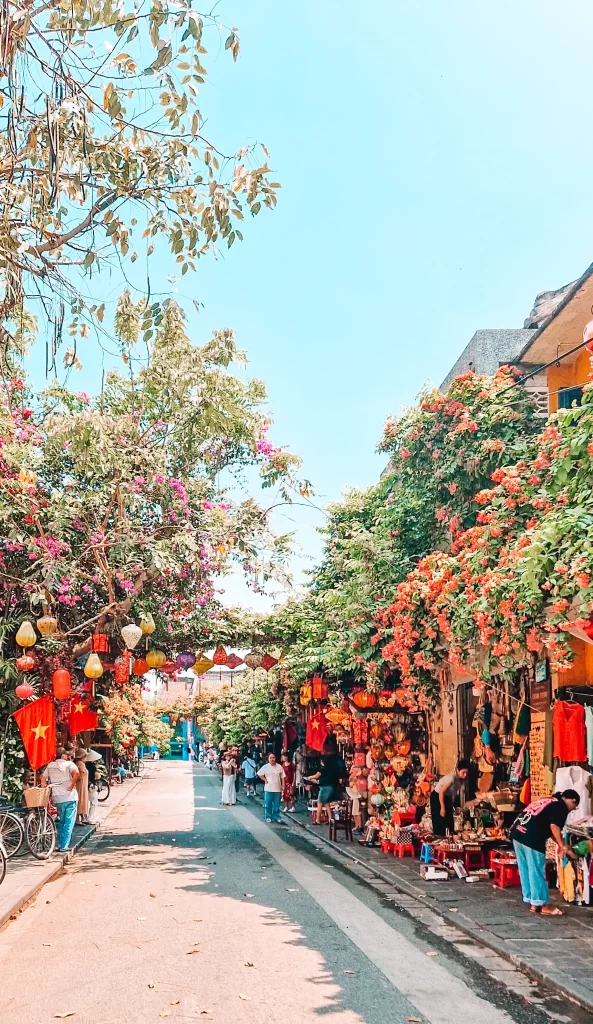
Hoi An has a way of staying with you long after you’ve left—whether it’s the glow of lanterns at dusk, the quiet charm of its backstreets, or the thrill of watching your custom outfit come to life. With the right mix of iconic sights and off-the-beaten-path gems, your time here can be as relaxed or adventurous as you want it to be. However you choose to explore, let this guide be your compass for a truly unforgettable Hoi An experience.



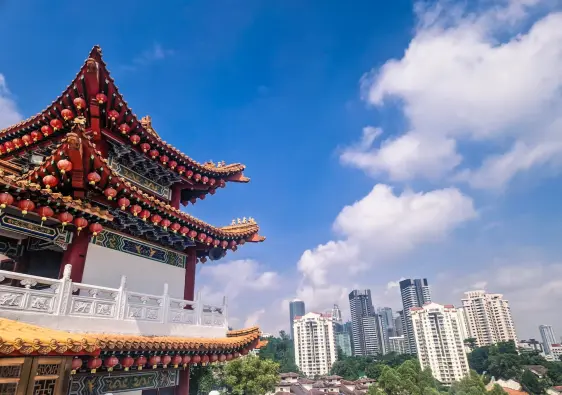

[…] Hoi An has seen relatively little change despite Vietnam’s rapid boom, and it retains its old-world charm. It’s one of Vietnam’s most historic cities, with beautiful buildings lining a picturesque river. The low-rise streets stand in complete contrast to neighbouring Da Nang, and are lined with small cafes, souvenir shops and the tailoring shops that have made Hoi An so famous. […]
[…] many cities in Asia, for example Hanoi and Hoi An in Vietnam, Siem Reap in Cambodia and George Town in Malaysia, Chiang Mai takes coffee seriously. […]
So many awesome tips here! Love the idea of taking a night lantern boat ride- sounds magical! Adding to my bucket list!
Hoi an is definitely one of my favorite cities in Vietnam! I loved my cooking class and just walking around town admiring all the lanterns. I did get some shorts tailored made but they were so many options I found it to be a bit overwhelming!
Love the idea of the reaching out tea stop. Such a great idea. And I’ve always wanted to get some clothes tailored so perhaps I need a trip here to do it!
Planning a trip to Vietnam, and this gave me a great feel for Hoi An. Adding it to my list — thanks for the helpful tips!
I love historical cities, just for that I would visit Hoi An. I would love to combine by staying in the city and in the rice fields, both sound so good.
Awesome blog post as always!🥰